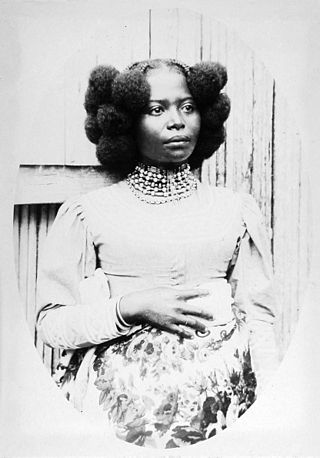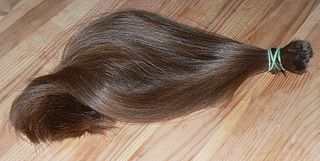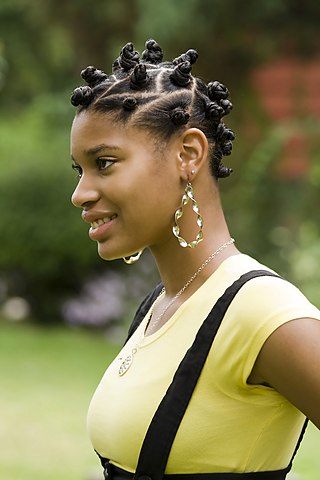
A hairstyle, hairdo, haircut or coiffure refers to the styling of hair, usually on the human head but sometimes on the face or body. The fashioning of hair can be considered an aspect of personal grooming, fashion, and cosmetics, although practical, cultural, and popular considerations also influence some hairstyles.

Dreadlocks, also known as locs or dreads, are rope-like strands of hair formed by matting or braiding hair.

The afro is a hair style created by combing out natural growth of afro-textured hair, unlike "fro" which is a hairstyle that can be achieved by curly or straight textured hair with tools or products. The hairstyle can be created by combing the hair away from the scalp, dispersing a distinctive curl pattern, and forming the hair into a rounded shape, much like a cloud or puff ball.

Cornrows are a style of braids in which the hair is braided very close to the scalp, using an underhand, upward motion to make a continuous, raised row. Cornrows are often done in simple, straight lines, as the term implies, but they can also be styled in elaborate geometric or curvilinear designs.
Artificial hair integrations, more commonly known as hair extensions, hair weaves, and fake hair add length and fullness to human hair. Hair extensions are usually clipped, glued, or sewn on natural hair by incorporating additional human or synthetic hair. These methods include tape-in extensions, clip-in or clip-on extensions, micro/nano rings, fusion method, weaving method, and wigs.

The conk was a hairstyle popular among African-American men from the 1920s up to early-mid 1960s. This hairstyle called for a man with naturally "kinky" hair to have it chemically straightened using a relaxer called congolene, an initially homemade hair straightener gel made from the extremely corrosive chemical lye which was often mixed with eggs and potatoes. The applier had to wear gloves and the solution timed just right on the applicant's head and then thoroughly rinsed out with cold water to avoid chemical burns. The desired outcome was for the newly straightened hair to be easily styled in the popular "conk" style of that era.
Dread perming is a chemical treatment that is used both by beauty salons and do-it-yourselfers to create or maintain dreadlocks. The hair is exposed to chemicals that render the hair frizzy. The frizzy hair is bound together and treated again to form the dreadlocks.

Kinky hair, also known as afro-textured hair, is a human hair texture prevalent in the indigenous populations of many regions with hot climates, mainly sub-Saharan Africa, Melanesia, and Australia. Each strand of this hair type grows in a tiny, angle-like helix shape. The overall effect is such that, contrasted with straight hair, wavy hair, or curly hair, kinky hair appears denser.

A hair tie is an item used to fasten hair, particularly long hair, away from areas such as the face. This is usually done as part of a hairstyle such as pigtails, bunches, or ponytails for straight, wavy, and loosely curled hair, and referred to as afro puffs, bunny tails, and "pineapples" for highly curled and highly textured natural hair. Two common types of hair tie are the scrunchie and the elastic. The term can also include a fixed tie or rubber band which is placed through or around strands to hold specific parts of hair together, rather than tie it or clasp them together like a hair clip.
Hair highlighting/lowlighting is changing a person's hair color, using lightener or haircolor to lift the level or brightness of hair strands. There are four basic types of highlights: foil highlights, hair painting, frosting, and chunking. Highlights can be any color, as long as it is a lighter level than the surrounding hair. Hair lightened with bleach or permanent color will be permanent until new growth begins to show. Highlighted hair can make the hair appear fuller. Therefore, it is sometimes recommended for people with thin and fine hair. It also a recommended service for achieving better color balance with people that have at least 50% gray, and it also helps to diminish the line of demarcation once the new growth is showing from permanent hair color.

African-American hair or Black hair refers to Afro-textured hair types, textures, and styles that are linked to African-American culture, often drawing inspiration from African hair culture. It plays a major role in the identity and politics of Black culture in the United States and across the diaspora. African-American hair often has a kinky hairy texture, appearing tightly coiled and packed. Black hair has a complex history, culture, and cultural impact, including its relationship with racism.
Discrimination based on hair texture, also known as texturism, is a form of social injustice, where afro-textured hair or coarse hair types are viewed negatively, often perceived as "unprofessional", "unattractive", or "unclean".

Hair theft has been a recurrent problem in various parts of the world where human hair is in demand, either for commercial products such as wigs and hairpieces, or for sexual fetishes. As hair has a high commercial value – in the mid-19th century it was regarded as worth twice its weight in silver – opportunist thieves have targeted long-haired women, and less commonly men and children, with the aim of stealing their hair. Hair thieves have typically sought either to surreptitiously cut off hair in public places, or have mugged people and shorn their heads. The crime of hair theft has been widely reported in North America, Europe, Asia, and Australasia over the course of at least 300 years.
The natural hair movement is a movement which aims to encourage people of African descent to embrace their natural, afro-textured hair. It originated in the United States during the 1960s, and resurged in popularity in the 2000s.

Box braids are a type of hair-braiding style that is predominantly popular among African people and the African diaspora. This type of hairstyle is a "protective style" and is "boxy", consisting of square-shaped hair divisions. Box braids are generally installed by using synthetic hair which helps to add thickness as well as helping the natural hair that is in the braid. Because they are not attached to the scalp like other similar styles such as cornrows, box braids can be styled in a number of different ways. The installation process of box braids can be lengthy, but once installed they can last for six to eight weeks. They are known for being easy to maintain.

Braids are a complex hairstyle formed by interlacing three or more strands of hair. Braiding has been used to style and ornament human and animal hair for thousands of years in various cultures around the world.
In the United States, discrimination based on hair texture is a form of social injustice that has been predominantly experienced by African Americans and predates the founding of the country.
Wicks are a hairstyle originating in South Florida. This hairstyle is prevalent amongst African-Americans. The hairstyle originated from Afro-Caribbeans in descent and are involved in the Hip-Hop community as well as related subgenres in Florida.

A protective hairstyle is a hairstyle that keeps the hair tucked away for minimum manipulation from the weather. Both cold and hot weather can pose as a threat to healthy hair because they contain elements that can be harmful to it such as frigid air, humidity, and water damage from rain and snow. Protective styles can help to retain length and growth. They include braids, wigs, locks, and twists. Some of the benefits of wearing protective hairstyles include: minimizing tangles and knots, giving the hair a break from tugging, pulling, and combing, and reducing the amount of time spent styling the hair.

Rogers v. American Airlines was a 1981 legal case decided by the United States District Court for the Southern District of New York involving plaintiff Renee Rogers, a Black woman who brought charges against her employer, American Airlines, for both sex and race discrimination after she was dissuaded from wearing her hair in cornrows due to the airline's employee grooming policy. Rogers believed that this hair policy was a violation of her Title VII rights.













